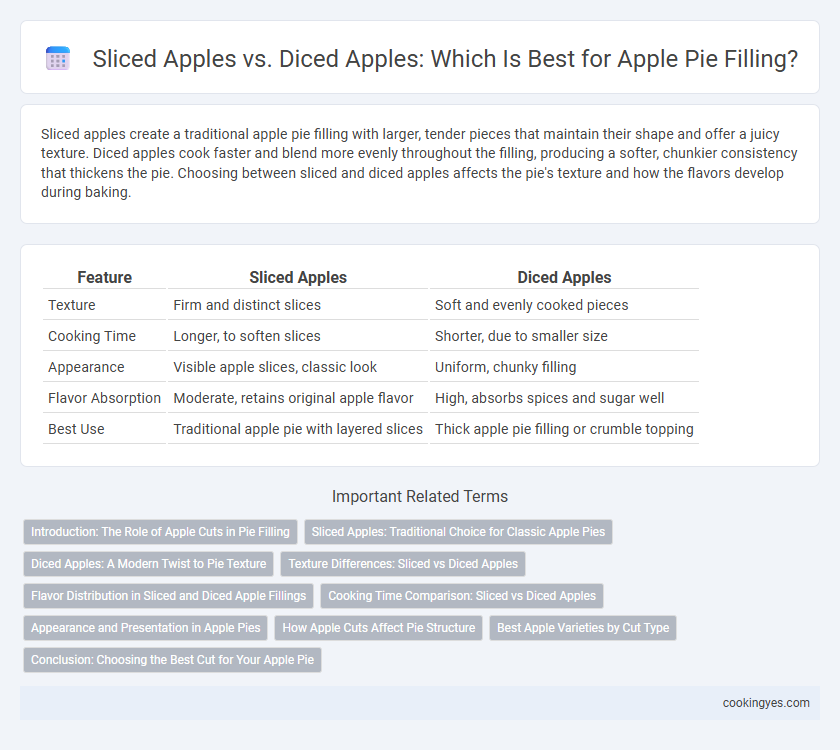Sliced apples create a traditional apple pie filling with larger, tender pieces that maintain their shape and offer a juicy texture. Diced apples cook faster and blend more evenly throughout the filling, producing a softer, chunkier consistency that thickens the pie. Choosing between sliced and diced apples affects the pie's texture and how the flavors develop during baking.
Table of Comparison
| Feature | Sliced Apples | Diced Apples |
|---|---|---|
| Texture | Firm and distinct slices | Soft and evenly cooked pieces |
| Cooking Time | Longer, to soften slices | Shorter, due to smaller size |
| Appearance | Visible apple slices, classic look | Uniform, chunky filling |
| Flavor Absorption | Moderate, retains original apple flavor | High, absorbs spices and sugar well |
| Best Use | Traditional apple pie with layered slices | Thick apple pie filling or crumble topping |
Introduction: The Role of Apple Cuts in Pie Filling
Sliced apples retain their shape and create a layered texture in apple pie filling, offering a firmer bite that contrasts with the soft, sweet filling. Diced apples break down faster during baking, blending smoothly into a thick, cohesive filling that intensifies overall flavor. Choosing between sliced and diced apples directly influences the pie's texture, moisture balance, and taste profile, making the apple cut critical for achieving the desired pie consistency.
Sliced Apples: Traditional Choice for Classic Apple Pies
Sliced apples retain their shape and texture during baking, making them the traditional choice for classic apple pies. They create distinct layers and a pleasing visual appeal, contributing to the pie's signature appearance. Using varieties like Granny Smith or Honeycrisp enhances flavor and consistency when sliced for the filling.
Diced Apples: A Modern Twist to Pie Texture
Diced apples provide a unique texture to apple pie filling by offering smaller, more uniform pieces that evenly absorb spices and sugar, enhancing flavor distribution. Their compact size allows for quicker cooking, resulting in a tender yet slightly firm bite that contrasts with the traditional softness of sliced apples. This modern twist on pie texture satisfies those seeking a blend of consistency and complexity in every slice.
Texture Differences: Sliced vs Diced Apples
Sliced apples in apple pie filling maintain a firmer, more structured texture, creating distinct layers that soften gradually during baking. Diced apples, by contrast, release more juices, resulting in a softer, more uniform filling with a smoother mouthfeel. Choosing between sliced or diced apples significantly impacts the pie's texture, influencing whether the filling retains individual apple pieces or blends into a cohesive consistency.
Flavor Distribution in Sliced and Diced Apple Fillings
Sliced apple fillings provide a more uniform texture with larger pieces that retain their shape, offering bursts of concentrated flavor in each bite. Diced apple fillings allow for better flavor distribution as the smaller pieces blend more evenly with sugar and spices, enhancing the overall taste throughout the pie. This finer cut facilitates caramelization and absorption of juices, resulting in a sweeter, more cohesive apple filling.
Cooking Time Comparison: Sliced vs Diced Apples
Sliced apples maintain their shape better and require a longer cooking time, typically around 15-20 minutes, to soften adequately in apple pie filling. Diced apples cook faster, usually within 10-12 minutes, due to their smaller, uniform pieces allowing for quicker heat penetration. Choosing between sliced and diced apples affects texture and cooking duration, with diced apples creating a more tender filling and sliced apples offering distinct apple pieces.
Appearance and Presentation in Apple Pies
Sliced apples in apple pie filling create a visually appealing layering effect, showcasing the natural shape and texture of each apple piece, which lends a rustic, classic look to the pie. Diced apples offer a more uniform and compact appearance, resulting in a consistent texture throughout the filling but less definition between individual pieces. The choice between sliced and diced apples directly impacts the pie's presentation, with sliced apples providing more dramatic, eye-catching slices and diced apples delivering a smoother, more cohesive filling.
How Apple Cuts Affect Pie Structure
Sliced apples retain more structural integrity during baking, resulting in a pie with distinct, tender apple layers that hold their shape well. Diced apples release more juice and soften faster, creating a denser, more uniform filling that can sometimes lead to a runnier pie base. Choosing sliced apples preserves the pie's traditional texture, while diced apples contribute to a more cohesive, jam-like consistency.
Best Apple Varieties by Cut Type
Sliced apples, such as Honeycrisp and Granny Smith, hold their shape well and provide a tender yet firm texture ideal for classic apple pie filling. Diced apples, like Fuji and Gala, break down more easily, creating a softer, more custard-like consistency preferred in sweeter, less structured pies. Choosing the right apple variety by cut type enhances flavor balance and texture, ensuring the pie filling bakes evenly with the desired mouthfeel.
Conclusion: Choosing the Best Cut for Your Apple Pie
Sliced apples retain their shape and provide a classic texture ideal for traditional apple pies, while diced apples break down more during baking, creating a thicker, more uniform filling. For a pie with distinct apple pieces and a firmer bite, sliced apples are the optimal choice, whereas diced apples suit recipes aiming for a softer, more cohesive filling. Selecting the best cut depends on your desired pie texture and presentation.
Sliced apples vs Diced apples for apple pie filling Infographic

 cookingyes.com
cookingyes.com